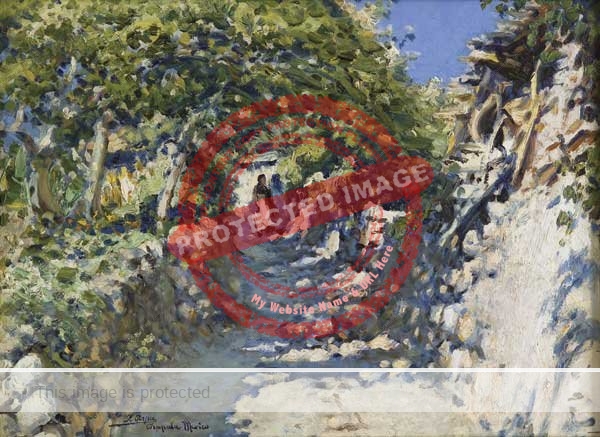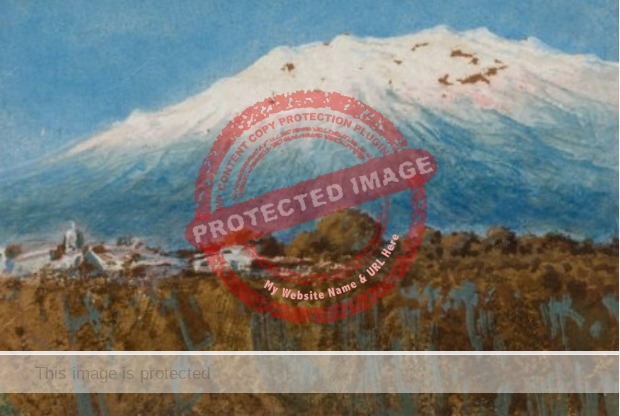Spanish-born artist José Arpa Perea (1858-1952), José Arpa to English-speakers, worked in Spain, Mexico and Texas. From his native Spain, Arpa arrived in Mexico in 1895. When the Mexican Revolution began in 1910 he relocated to San Antonio, Texas. Arpa made frequent trips back to Spain, and in 1931, returned to live and work there.
We know he spent some time in Chapala on account of this beautiful oil painting of Chapala, Mexico, sold at auction in 2006 for $24,000. Arpa specialized in landscapes (with occasional portraits), and we know that he painted in various parts of Mexico, predominantly central Mexico.
Born in Carmona, Spain, Arpa first studied art in 1876 under Eduardo Cano de la Peña at the Museum of Fine Arts in Seville. He also studied in Rome, Italy (1883-1886). His paintings are pre-impressionist in style, and his best works rely on brilliant colors and a particular skill in depicting the effects of sunlight. Four of his canvases were exhibited, on behalf of Spain, at the Chicago World’s Fair in 1893.
In 1895, Arpa traveled to Morocco, and then to Mexico. It is possible that his decision to live in Mexico was on account of previous meetings in Seville with members of two Spanish families – Rivero and Quijano – who were residents of Puebla, Mexico. Arpa declined an invitation to become director of Mexico’s Academy of Fine Arts, and worked independently, painting the local landscapes and customs.
Arpa spent time in Jalapa, Veracruz, a city of some artistic renown at that time, and had several works accepted for the XXIII Exhibition of the National Fine Arts School (Escuela Nacional de Bellas Artes) in Mexico City, which opened in January 1899.
In Puebla, Arpa undertook the interior decoration of several city homes. He had painted several murals previously in Spain, but apparently none of them survive, whereas some of his Neo-Mudéjar (Moorish Revival) stucco and mural work in Puebla still exist.
In Texas (after the Mexican Revolution began in 1910) Arpa established his studio in San Antonio and painted the rivers, flowers and rich, blue skies of the Texas Hill Country. His work influenced many painters in Texas, including Xavier Gonzalez (his nephew, and assistant in drawing classes), Octavio Medellín, and Porfirio Salinas.
Arpa’s work has been widely exhibited and won many awards. Ten of his paintings are in the permanent collection of the San Antonio Museum of Art. In 2015, the Museum held a major exhibition of his works, entitled “The Three Worlds of José Arpa y Perea: Spain, Mexico, and San Antonio”.
Previously, in 1998, a major retrospective of his paintings, including some of his American works, had been held in Seville, the city where he spent his final years.
Main sources:
- Montserrat Galí Boadella. 2000. José Arpa Perea En México (1895-1910). Laboratorio de Arte 13 (2000) 241-261.
- J. Fernández Lacomba. 1998. José Arpa Perea (Catálogo de la Exposición), Sevilla, Fundación El Monte.
Sombrero Books welcomes comments, corrections or additional material related to any of the writers and artists featured in our series of mini-bios. Please email us or use the comments feature at the bottom of individual posts.
Tony Burton’s books include “Lake Chapala: A Postcard History” (2022), “Foreign Footprints in Ajijic” (2022), “If Walls Could Talk: Chapala’s historic buildings and their former occupants” (2020), (available in translation as “Si Las Paredes Hablaran”), “Mexican Kaleidoscope” (2016), and “Lake Chapala Through the Ages” (2008).


Thank you for this fascinating and informative blog post. This caught my attention because I am writing about a bit about Xavier González in a book on Far West Texas. For a time he headed the summer art colony in the Big Bend. González also painted the magnificent “Moonlight Over the Chisos” which is displayed in the Museum of the Big Bend on the Sul Ross campus in Alpine, Texas. There is more about González and some of his colleagues in my interview with curator of 2012 show “The Lost Colony” Mary Bones here
http://www.cmmayo.com/marfa/podcast-3-mary-bones-lost-art-colony.html
And a blog post with more notes from 2016 here
http://madammayo.blogspot.mx/2016/05/notes-on-xavier-gonzalez-1898-1993.html
About Arpa, I would love to read more. I have not yet been able to ascertain exactly what happened with his invitation to head the Academia de San Carlos. Certainly Arpa, González, and the others deserve more notice as important artists in both Mexico and Texas, and also as important transcultural artists.
Thank you for this post, and I hope I can look forward to reading more.
On the contrary, thank YOU for adding to my knowledge of José Arpa! Please do let me know if you find out more about him.
While he plays only a minor role in the “Lake Chapala Art Story” I entirely agree that he is one of the many, almost-forgotten artists who deserve to be much more widely recognized, both in Mexico and elsewhere.